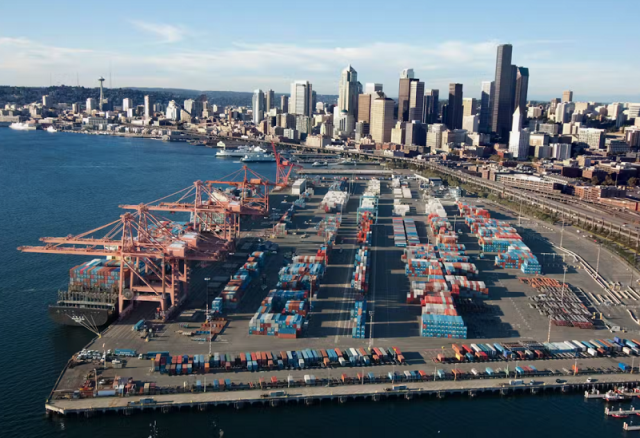One of the first things that businesses or people who want to bring items from China to the US have to do is figure out how much it will actually cost to get those goods to the US. The price a supplier gives you for a product is simply one element of the equation. Shipping, insurance, customs tariffs, processing fees, and occasionally even surprise charges along the way are all real costs. If you don't grasp these things, your profit margins could soon drop, or you could get frustrated when shipments come with surprise expenses. To avoid this, it's crucial to know how to precisely estimate both taxes and freight. Working with a China freight forwarder may make what often looks like a convoluted procedure easier.
Learning the most important trade phrases that spell out the duties of buyers and sellers is a smart place to start. One of the most essential ones is "cif meaning." CIF means "Cost, Insurance, and Freight." This means that the seller is responsible for getting the items to the target port and paying for the goods, freight, and insurance up to that point. But with CIF, the buyer takes on the risk of loss or damage as soon as the products are placed onto the ship. The buyer is also in charge of customs clearance, duties, and getting the items to their final destination in the United States. Other phrases, like FOB (Free on Board), work differently and put more obligation on the buyer sooner. Importers can better prepare for the charges they will have to pay by knowing these Incoterms.
Choosing the route of transportation is the first step in figuring out how much shipping will cost. Sea freight is still the cheapest way to ship large amounts of goods, whether it's a full container load or a shared container (called less than container load, or LCL). It takes longer, but it's cheaper for big or heavy items. Air freight is much faster but also much more expensive. It is best for things that need to get there quickly or are worth a lot of money. Express couriers are in the middle and are commonly employed for little packages. The distance between the port of origin in China and the port of destination in the United States also affects the cost. Transport within the United States, like trucks or rail, may add even more costs. Freight rates change based on things like market demand, fuel prices, and even the seasons. This means that bids might change a lot over time.
Another thing to think about is insurance. Sellers must include insurance in CIF terms, but not all shipping arrangements do. In many circumstances, purchasers choose to buy their own insurance. Insurance is usually a small fraction of the entire worth of the cargo, but it gives you peace of mind that you won't lose or damage your goods while they're being shipped. Importers also have to pay for port handling fees, export costs at the source, and expenditures for packaging or loading. All of these things amount to the total cost of shipping, and importers can only get a good idea of how much it will cost to ship by adding them all together.
After the items get to the United States, the next big cost is customs duties and taxes. The CIF value, which is the declared customs value, usually includes the cost of the products, shipping, and insurance. U.S. Customs and Border Protection uses this value to set tariffs. The Harmonized Tariff Schedule (HTS) code puts each product into a group, and the duty rate depends on that group. For instance, a product that has a basic charge of 4% may cost a lot more if it comes into a group that has to pay extra duties, such as the Section 301 tariffs that are currently in place on numerous commodities from China. In that situation, the total duty could go up to about thirty percent or more, which would change the cost of the shipping by a lot.
Importers have to pay more than just their normal duties. Most imports have to pay the Merchandise Processing Fee (MPF), which is normally a percentage of the customs value with a minimum and maximum limit. The Harbor Maintenance Fee (HMF) is also charged on maritime shipments, and it is similarly a percentage of the cargo value. These fees may not seem like much compared to the base tariff, but they can mount up, especially for importers who bring in a lot of goods. State sales tax or use tax is another thing that depends on where the goods are finally sold or delivered in the US. If some items fall into certain sensitive categories, they may also have to pay excise taxes or anti-dumping levies. When you add up all of these fees, the overall cost of a shipment can be far greater than just the supplier's invoice and a shipping quote.
Think about a simple case. A Chinese manufacturer sells $5,000 worth of goods to an importer. The freight forwarder says that sea freight will cost $800 and insurance would cost $50. That makes the CIF value $5,850. The importer owes $234 if the HTS classification has a base duty of 4%. But if the items are subject to a twenty-five percent Section 301 tax, another $1,462 is imposed, bringing the total duty to nearly $1,700. The real landed cost may easily be greater than $7,600 when you add in the MPF, HMF, and state taxes. This example shows why it's important to do the math carefully before placing an order.
For a lot of importers, figuring out freight costs, insurance, tariffs, and customs procedures can be too much to handle. That's why working with a competent China freight forwarder may be so helpful. A forwarder with a lot of experience in U.S. trade will not only get you the best freight quotations, but they will also help you choose the best shipping method for your needs, take care of export paperwork, set up insurance, and make sure the items are properly classified under the HTS system. Forwarders also connect shippers, carriers, customs brokers, and final delivery services, making sure that information flows smoothly and mistakes that cost a lot of money are less likely to happen. More crucially, they can give importers precise estimates of the landing cost before the items are transported, so there are no hidden expenses.
U.S. import rules have changed quickly in the last few years. Changes in duty rates might happen when there are trade disputes or changes in tariffs. Unpredictably, freight rates can go up as fuel prices go up or ports are busy. The "de minimis" regulation, which used to let shipments worth less than $800 enter without paying duty, is also being looked at more closely. Businesses that rely on steady supply chains can't keep pace with these developments without aid from experts. This is one more reason why a lot of businesses use freight forwarders or logistics service providers that have worldwide networks and up-to-date information.
Presou Logistic is one of these companies. It is an international freight forwarding firm with more than ten years of expertise. It offers full logistics services, from picking up goods in China to declaring them at customs and delivering them to homes throughout the world. They have offices in major Chinese ports and have been working with logistics agents in more than 160 countries for a long time. This gives them both deep local knowledge and a worldwide reach. They are a reliable partner for firms that need to transfer goods across borders quickly since they have certified customs knowledge, 24/7 customer support, and can handle every step in the chain.
Finally, figuring out the cost of shipping and taxes from China to the U.S. is not just a matter of adding up figures. You also need to know what your responsibilities are under Incoterms like CIF, how U.S. customs duties are calculated, and what fees you might have to pay. There are a lot of moving components in the process, such as the mode of transportation, insurance, taxes, customs clearance, and ultimate delivery. An importer can put all of this together on their own, but the chances of making a mistake are considerable, and the consequences for mistakes can be severe. When you work with an experienced China freight forwarder, you can be sure that your shipments will arrive on time and on budget. This expert help is not only helpful but also necessary for firms that wish to focus on growth instead of red tape.






